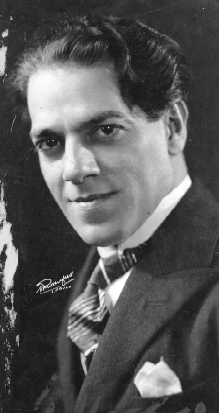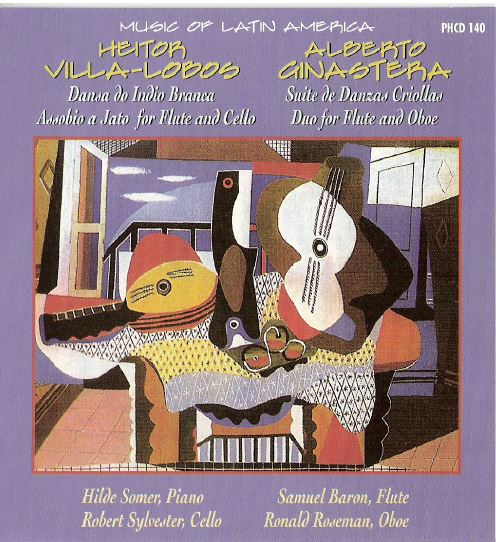
Villa-Lobos, Heitor
Heitor Villa-Lobos March 5, 1887 – November 17, 1959) was a Brazilian composer, conductor, cellist, and classical guitarist described as “the single most significant creative figure in 20th-century Brazilian art music”.[5] Villa-Lobos has become the best-known South American composer of all time.[6] A prolific composer, he wrote numerous orchestral, chamber, instrumental and vocal works, totaling over 2000 works by his death in 1959. His music was influenced by both Brazilian folk music and by stylistic elements from the European classical tradition, as exemplified by his Bachianas Brasileiras (Brazilian Bachian-pieces) and his Chôros. His Etudes for classical guitar (1929) were dedicated to Andrés Segovia, while his 5 Preludes (1940) were dedicated to his spouse Arminda Neves d’Almeida, a.k.a. “Mindinha.” Both are important works in the classical guitar repertory.
On November 12, 1913, Villa-Lobos married the pianist Lucília Guimarães,[10] ended his travels, and began his career as a serious musician. Up until his marriage, he had not learned to play the piano, so his wife taught him the rudiments of the instrument.[11] His music began to be published in 1913. He introduced some of his compositions in a series of occasional chamber concerts (later also orchestral concerts) from 1915–1921, mainly in Rio de Janeiro’s Salão Nobre do Jornal do Comércio.
The music presented at these concerts shows his coming to terms with the conflicting elements in his experience, and overcoming a crisis of identity, as to whether European or Brazilian music would dominate his style. This was decided by 1916, the year in which he composed the symphonic poems Amazonas and Tédio de alvorada, the first version of what would become Uirapurú (although Amazonas was not performed until 1929, and Uirapurú was only completed in 1934 and first performed in 1935). These works drew from native Brazilian legends and the use of “primitive” folk material.[12]
European influences did still inspire Villa-Lobos. In 1917 Sergei Diaghilev made an impact on tour in Brazil with his Ballets Russes. That year Villa-Lobos also met the French composer Darius Milhaud, who was in Rio as secretary to Paul Claudel at the French Legation. Milhaud brought the music of Claude Debussy, Erik Satie, and possibly Igor Stravinsky; in return Villa-Lobos introduced Milhaud to Brazilian street music. In 1918, he also met the pianist Arthur Rubinstein, who became a lifelong friend and champion; this meeting prompted Villa-Lobos to write more piano music.[13]
In about 1918 Villa-Lobos abandoned the use of opus numbers for his compositions as a constraint to his pioneering spirit. With the piano suite Carnaval das crianças (Children’s carnival) of 1919–20, Villa-Lobos liberated his style altogether from European Romanticism:[14] the suite, in eight movements with the finale written for piano duet, depicts eight characters or scenes from Rio’s Lenten Carnival.
In February 1922, a festival of modern art took place in São Paulo and Villa-Lobos contributed performances of his own works. The press were unsympathetic and the audience were not appreciative; their mockery was encouraged by Villa-Lobos’s being forced by a foot infection to wear one carpet slipper.[15] The festival ended with Villa-Lobos’s Quarteto simbólico, composed as an impression of Brazilian urban life.
In July 1922, Rubinstein gave the first performance of the piano suite A Prole do Bebê (The Baby’s Family), composed in 1918. There had recently been an attempted military coup on Copacabana Beach, and places of entertainment had been closed for days; the public possibly wanted something less intellectually demanding, and the piece was booed. Villa-Lobos was philosophical about it, and Rubinstein later reminisced that the composer said, “I am still too good for them.” The piece has been called “the first enduring work of Brazilian modernism”.[16]
Rubinstein suggested that Villa-Lobos tour abroad, and in 1923 he set out for Paris. His avowed aim was to exhibit his exotic sound world rather than to study. Just before he left he completed his Nonet (for ten players and chorus) which was first performed after his arrival in the French capital. He stayed in Paris in 1923–24 and 1927–30, and there he met influential residents including Edgard Varèse, Pablo Picasso, Leopold Stokowski and Aaron Copland. Parisian concerts of his music made a strong impression.[17]
In the 1920s, Villa-Lobos also met the Spanish classical guitarist Andrés Segovia, who commissioned a guitar study: the composer responded by writing a set of twelve such pieces, each based on a tiny detail or figure played by Brazilian itinerant street musicians (chorões), transformed into a étude that is not merely didactic. The music of chorões also provided the initial inspiration for his Chôros, a series of compositions written between 1920 and 1929. The first European performance of Chôros No. 10, in Paris, caused a storm: L. Chevaillier wrote of it in Le Monde musical, “[…it is] an art […] to which we must now give a new name.”[18]
Villa-Lobos was able, after the end of the war, to travel abroad again; he returned to Paris, and also made regular visits to the United States as well as travelling to Great Britain, and Israel. He received a huge number of commissions, and fulfilled many of them despite failing health. He composed concertos for piano, cello (the second one in 1953), classical guitar (in 1951 for Segovia, who refused to play it until the composer provided a cadenza in 1956),[23] harp (for Nicanor Zabaleta in 1953) and harmonica (for John Sebastian, Sr. in 1955–6). Other commissions included his Symphony No. 11 (for the Boston Symphony Orchestra in 1955), and the opera Yerma (1955–56) based on the play by Federico García Lorca. His prolific output of this period prompted criticisms of note-spinning and banality: critical reactions to his Piano Concerto No. 5 included the comments “bankrupt” and “piano tuners’ orgy”,[24] “raked the very depths of banality”, “nothing … but soupy textures or a bedraggled romantic idea”, and “truly the kind of music that should never get written, still less performed”.[25]
His music for the film Green Mansions starring Audrey Hepburn and Anthony Perkins, commissioned by MGM in 1958, earned Villa-Lobos US$25,000, and he conducted the soundtrack recording himself.[26] The film was in production for many years. Originally to be directed by Vincente Minnelli, it was taken over by Hepburn’s husband Mel Ferrer.[27] MGM decided to use only part of Villa-Lobos’s music in the actual film, turning instead to Bronislau Kaper for the rest of the music.[28] From the score, Villa-Lobos compiled a work for soprano soloist, male chorus, and orchestra, which he titled Forest of the Amazon and recorded it in 1959 in stereo with Brazilian soprano Bidu Sayão, an unidentified male chorus, and the Symphony of the Air for United Artists Records. The recording was issued both on LP and reel-to-reel tape (United Artist UAC 8007, stereo 7 1/2 IPS).[29][failed verification][unreliable source?]
In June 1959, Villa-Lobos alienated many of his fellow musicians by expressing disillusionment, saying in an interview that Brazil was “dominated by mediocrity”.[30] In November he died in Rio; his state funeral was the final major civic event in that city before the capital transferred to Brasília.[31] He is buried in the Cemitério São João Batista in Rio de Janeiro.
